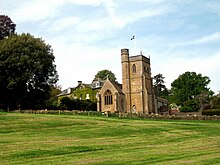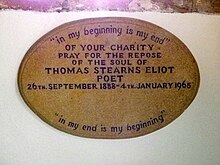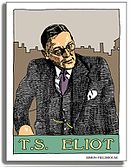
Thomas Stearns Eliot was a poet, essayist, publisher, playwright, literary critic and editor. He is considered to be one of the 20th century's greatest poets, as well as a central figure in English-language Modernist poetry. His use of language, writing style, and verse structure reinvigorated English poetry. He is also noted for his critical essays, which often reevaluated long-held cultural beliefs.

Charles Eliot Norton was an American author, social critic, and Harvard professor of art based in New England. He was a progressive social reformer and a liberal activist whom many of his contemporaries considered the most cultivated man in the United States. He was from the same notable Eliot family as the 20th-century poet T. S. Eliot, who made his career in the United Kingdom.

"The Love Song of J. Alfred Prufrock", commonly known as "Prufrock", is the first professionally published poem by American-born British poet T. S. Eliot (1888–1965). The poem relates the varying thoughts of its title character in a stream of consciousness. Eliot began writing "Prufrock" in February 1910, and it was first published in the June 1915 issue of Poetry: A Magazine of Verse at the instigation of fellow American expatriate Ezra Pound. It was later printed as part of a twelve-poem chapbook entitled Prufrock and Other Observations in 1917. At the time of its publication, "Prufrock" was considered outlandish, but the poem is now seen as heralding a paradigmatic shift in poetry from late 19th-century Romanticism and Georgian lyrics to Modernism.

Cleanth Brooks was an American literary critic and professor. He is best known for his contributions to New Criticism in the mid-20th century and for revolutionizing the teaching of poetry in American higher education. His best-known works, The Well Wrought Urn: Studies in the Structure of Poetry (1947) and Modern Poetry and the Tradition (1939), argue for the centrality of ambiguity and paradox as a way of understanding poetry. With his writing, Brooks helped to formulate formalist criticism, emphasizing "the interior life of a poem" and codifying the principles of close reading.

"Ode on a Grecian Urn" is a poem written by the English Romantic poet John Keats in May 1819, first published anonymously in Annals of the Fine Arts for 1819.
"Gerontion" is a poem by T. S. Eliot that was first published in 1920 in Ara Vos Prec and Poems. The title is Greek for "little old man," and the poem is an interior monologue relating the opinions and impressions of an elderly man, which describes Europe after World War I through the eyes of a man who has lived most of his life in the 19th century. Two years after it was published, Eliot considered including the poem as a preface to The Waste Land, but was talked out of this by Ezra Pound. Along with "The Love Song of J. Alfred Prufrock" and The Waste Land, and other works published by Eliot in the early part of his career, '"Gerontion" discusses themes of religion, sexuality, and other general topics of modernist poetry.

George Sutherland Fraser was a Scottish poet, literary critic and academic.

The Cantos by Ezra Pound is a long poem in 109 sections plus a number of drafts and fragments added as a supplement at the request of the poem's American publisher, James Laughlin. Most of it was written between 1915 and 1962, although much of the material in the first three cantos was abandoned or redistributed in 1923, when Pound prepared the first instalment of the poem, A Draft of XVI Cantos. It is a book-length work, widely considered to present formidable difficulties to the reader. Strong claims have been made for it as the most significant work of modernist poetry of the twentieth century. As in Pound's prose writing, the themes of economics, governance and culture are integral to its content.

"Ode: Intimations of Immortality from Recollections of Early Childhood" is a poem by William Wordsworth, completed in 1804 and published in Poems, in Two Volumes (1807). The poem was completed in two parts, with the first four stanzas written among a series of poems composed in 1802 about childhood. The first part of the poem was completed on 27 March 1802 and a copy was provided to Wordsworth's friend and fellow poet, Samuel Taylor Coleridge, who responded with his own poem, "Dejection: An Ode", in April. The fourth stanza of the ode ends with a question, and Wordsworth was finally able to answer it with seven additional stanzas completed in early 1804. It was first printed as "Ode" in 1807, and it was not until 1815 that it was edited and reworked to the version that is currently known, "Ode: Intimations of Immortality".
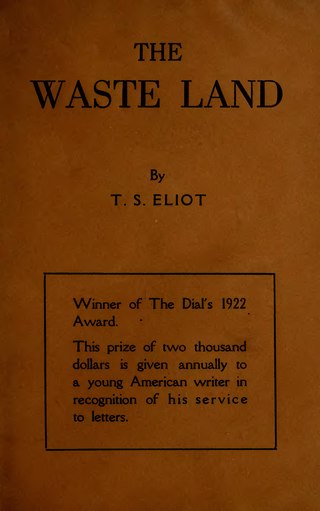
The Waste Land is a poem by T. S. Eliot, widely regarded as one of the most important English-language poems of the 20th century and a central work of modernist poetry. Published in 1922, the 434-line poem first appeared in the United Kingdom in the October issue of Eliot's magazine The Criterion and in the United States in the November issue of The Dial. Among its famous phrases are "April is the cruellest month", "I will show you fear in a handful of dust", and "These fragments I have shored against my ruins".
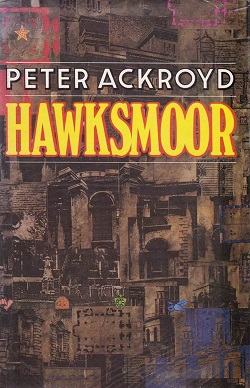
Hawksmoor is a 1985 novel by English writer Peter Ackroyd. It won Best Novel at the 1985 Whitbread Awards and the Guardian Fiction Prize. It tells the parallel stories of Nicholas Dyer, who builds seven churches in 18th-century London for which he needs human sacrifices, and Nicholas Hawksmoor, detective in the 1980s, who investigates murders committed in the same churches. Hawksmoor has been praised as Peter Ackroyd's best novel and an example of postmodernism.

The Dry Salvages is the third poem of T. S. Eliot's Four Quartets, marking the beginning of the point when the series was consciously being shaped as a set of four poems. It was written and published in 1941 during the air-raids on Great Britain, an event that threatened him while giving lectures in the area. The title comes from the name of a marine rock formation off the coast of Cape Ann, Massachusetts, where he spent time at as a child.
Little Gidding is the fourth and final poem of T. S. Eliot's Four Quartets, a series of poems that discuss time, perspective, humanity, and salvation. It was first published in September 1942 after being delayed for over a year because of the air-raids on Great Britain during World War II and Eliot's declining health. The title refers to a small Anglican community in Little Gidding in Huntingdonshire, established by Nicholas Ferrar in the 17th century and scattered during the English Civil War.
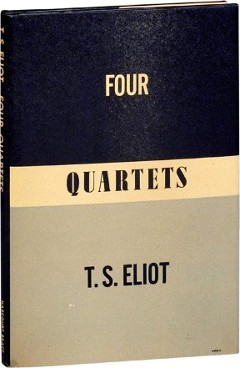
Four Quartets is a set of four poems written by T. S. Eliot that were published over a six-year period. The first poem, Burnt Norton, was published with a collection of his early works. After a few years, Eliot composed the other three poems, East Coker, The Dry Salvages, and Little Gidding, which were written during World War II and the air-raids on Great Britain. They were first published as a series by Faber and Faber in Great Britain between 1940 and 1942 towards the end of Eliot's poetic career. The poems were not collected until Eliot's New York publisher printed them together in 1943.

Burnt Norton is the first poem of T. S. Eliot's Four Quartets. He created it while working on his play Murder in the Cathedral, and it was first published in his Collected Poems 1909–1935 (1936). The poem's title refers to the manor house Eliot visited with Emily Hale in the Cotswolds. The manor's garden serves as an important image within the poem. Structurally, the poem is based on Eliot's The Waste Land, with passages of the poem related to those excised from Murder in the Cathedral.

The Curse of Kehama is an 1810 epic poem composed by Robert Southey. The origins of the poem can be traced to Southey's schoolboy days when he suffered from insomnia, along with his memories of a dark and mysterious schoolmate that later formed the basis for one of the poem's villains. The poem was started in 1802 following the publication of Southey's epic Thalaba the Destroyer. After giving up on the poem for a few years, he returned to it after prompting by the poet Walter Savage Landor encouraged him to complete his work. When it was finally published, it sold more copies than his previous works.

The T. S. Eliot bibliography contains a list of works by T. S. Eliot.
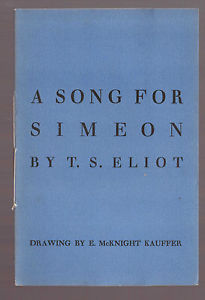
"A Song for Simeon" is a 37-line poem written in 1928 by American-English poet T. S. Eliot (1888–1965). It is one of five poems that Eliot contributed to the Ariel Poems series of 38 pamphlets by several authors published by Faber and Gwyer. "A Song for Simeon" was the sixteenth in the series and included an illustration by avant garde artist Edward McKnight Kauffer. The poems, including "A Song for Simeon", were later published in both the 1936 and 1963 editions of Eliot's collected poems.
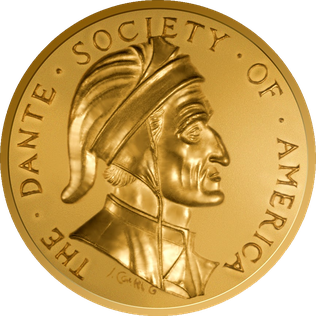
The Dante Society of America is an American academic society devoted to the study of Dante Alighieri. One of the oldest scholarly societies in North America, it predates both the Modern Language Association, founded in 1883, and the American Historical Association, founded in 1884. After the German Dante Society, it is the second-oldest scholarly organization devoted to the study of Dante. The Society was also one of the first scholarly societies in the United States to have women among its founding members. The current president is Alison Cornish of New York University.
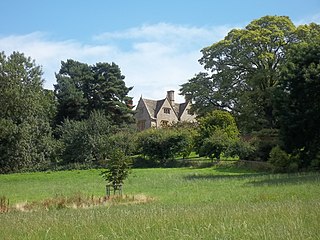
Burnt Norton is a manor house in Aston-sub-Edge, near Chipping Campden, Gloucestershire, best known for being the inspiration for T. S. Eliot's poem of the same name.
